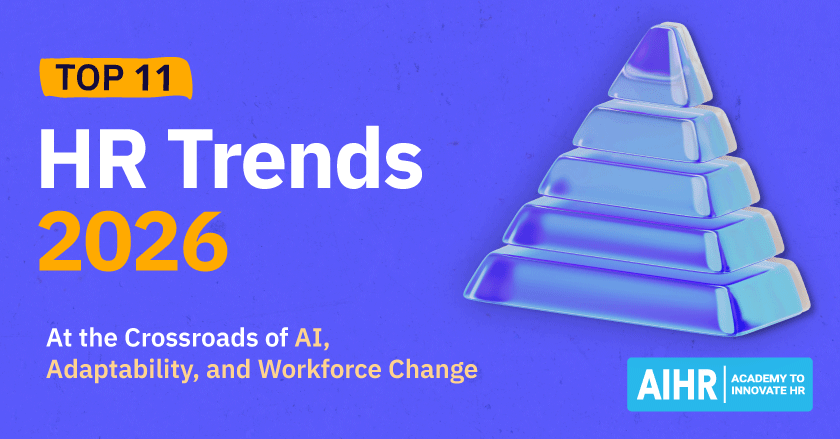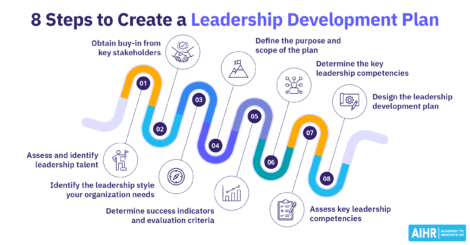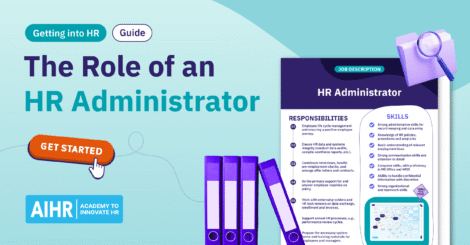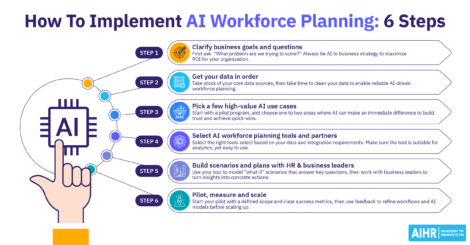Employees who feel underpaid are 45% more likely to look for a new job — even if their pay is at or above market levels. This makes it essential for organizations to review pay practices regularly and ensure they’re both fair and competitive.
A compensation analysis template streamlines the process by helping you structure data collection and salary benchmarking. This article explains what a compensation analysis entails and how a template can help you conduct one. It also comes with a free compensation analysis template you can customize to meet organizational needs.
Contents
What is a compensation analysis?
HR’s role in compensation analysis
Why use a compensation analysis template?
Key sections of a compensation analysis template
Free compensation analysis template
Conducting a compensation analysis: 9 HR tips
6 compensation analysis examples
What is a compensation analysis?
A compensation analysis helps ensure fair, competitive pay practices aligned with business goals. It involves reviewing employee pay to confirm it reflects company strategy, complies with regulations, and matches external benchmarks. As part of compensation analytics — the data-driven approach to managing pay — it supports performance and trust.
In practice, this means examining compensation and benefits (including salaries and bonuses) across the organization. The goal is internal fairness and external competitiveness. A compensation market analysis compares pay structures with industry and regional standards, helping you spot gaps, correct imbalances, align pay with role value, and improve attraction and retention.
A compensation analysis supports several business goals:
- Pay equity: By reviewing pay across categories such as gender, race, or tenure, you can address inequities and build employee trust.
- Compliance: Regular reviews help ensure adherence to equal pay and labor laws, reducing regulatory risk.
- Talent attraction and retention: Competitive compensation is a proven driver of recruitment and employee loyalty.
- Market alignment: Benchmarking against external data keeps your pay packages in line with industry standards.
The importance of compensation analysis comes down to three key outcomes:
- Reducing legal risk: Identifying inequities early helps avoid lawsuits, fines, and reputational damage.
- Boosting employee satisfaction: Fair pay practices improve engagement, productivity, and loyalty.
- Strengthening hiring competitiveness: In tight labor markets, transparent and competitive pay can set your organization apart.
Getting compensation right is about building a system that reflects fairness, supports company strategy, and positions you as an employer of choice.
HR’s role in compensation analysis
Below are the key aspects of HR’s role in the compensation analysis process:
Collect, interpret, and report on pay data
HR gathers accurate internal pay data (salaries, bonuses, benefits) and external benchmarks (surveys, labor market reports), then identifies trends, disparities, and needed adjustments. This analysis underpins fair, consistent, and competitive pay.
Partner with finance and leadership
HR works with finance to align budgets and with leadership to tie pay to business goals, then brings insights from compensation analytics. At the same time, finance ensures affordability, and leadership sets direction. Together, they make pay decisions that support strategy and growth.
Ensure compliance with laws and regulations
HR must ensure compensation practices meet federal and state requirements, including the Equal Pay Act and other relevant labor laws. A thorough compensation analysis helps spot potential risks early, reducing the chance of penalties or legal disputes.
Communicate results and recommendations
HR must turn analysis into action using a compensation analysis report. Your responsibility is to highlight key findings, risks, and recommended changes to leadership and other key stakeholders. Clear reporting helps leaders make informed pay decisions and strengthens employee trust.
Master compensation analysis to retain your best people
To attract, retain and engage top talent with competitive pay packages, you must conduct compensation analyses that effectively balance business goals with employee satisfaction.
✅ Learn to gather and analyze the data you need to answer business questions
✅ Optimize total rewards and connect base pay to retention with analytics
✅ Understand the effectiveness of your existing C&B strategy using data analysis
✅ Analyze your C&B data to identify pay gaps and understand reward drivers
🎓 Learn at your own pace with the online Compensation & Benefits Certificate Program.
Why use a compensation analysis template?
Conducting a compensation analysis can feel overwhelming — there’s a lot of data to gather, review, and compare. A well-structured template will guide you through the process, ensure consistency, and provide a clear format for presenting results in a professional compensation analysis report.
Here’s what a template can do for you:
- Save time and ensure consistency: Instead of starting from scratch each time, you’ll have a ready-made framework that helps structure every analysis the same way, making it easier to compare results across teams, departments, or years.
- Reduce human error and support compliance: A checklist-style template ensures that you don’t overlook anything. You’re less likely to miss key data, forget a benchmark, or skip a compliance check, all of which can create unnecessary risks.
- Make data easier to interpret: By putting complex numbers into clear tables, charts, and categories, a template makes raw data easily accessible. This saves time in meetings and makes it easier to explain why certain decisions are necessary.
- Improve decision-making: Organized, consistent pay data removes reliance on guesswork. Instead, leadership can use the insights from your compensation analysis report to make informed choices about salaries, raises, and benefits.
- Scale across your organization: You can roll out a single, standardized template to different HR teams or business units. Everyone follows the same process, which creates uniformity and strengthens your company-wide pay strategy.
- Encourage accountability and transparency: A structured compensation analysis report clarifies how your team reached certain decisions. This not only builds trust among staff but also provides a paper trail for leadership or auditors.
- Enable historical tracking: Using the same template year after year creates a valuable record. You’ll be able to see how pay structures have changed over time, spot long-term trends, and make proactive adjustments before issues arise.
Key sections of a compensation analysis template
While compensation analysis templates may differ depending on the type of analysis and the intended outcome, there are some elements every template should have. Here are the sections you should include in yours:
Employee information
Details such as job title, department, location, and tenure give essential context to pay data. Without this, it’s impossible to compare like with like. Including job level or grade can also help distinguish between entry-level, mid-level, and senior roles.
Current salary and total compensation
Base pay is only one part of the picture. Adding bonuses, benefits, allowances, and equity gives you a complete view of how your company rewards employees. Capturing this information ensures you’re comparing total rewards, not just salaries.
Market salary benchmark data
External benchmarks are crucial for assessing competitiveness. This shows how your salaries compare to industry standards and regional averages. Including multiple sources (e.g., surveys and government data) adds credibility to your findings.
The SHRM Compensation Data Center and WorldatWork’s Salary Data Center are two useful tools for comparing salaries across roles, industries, and locations.
Internal pay comparisons
Looking at pay within departments and across the organization helps highlight inconsistencies and potential equity issues. For example, two employees in similar roles but different business units may have very different compensation packages — something your analysis should surface.
Pay equity indicators
Factors such as gender, ethnicity, or age allow you to identify patterns of inequity and address them proactively. Tracking these alongside pay outcomes helps you demonstrate fairness and reduce compliance risk.
Free compensation analysis template
AIHR has created a free compensation analysis template, which offers a clear structure for collecting data, comparing pay, building a professional compensation analysis report, and tracking changes over time. You can also tailor it to match your organization’s goals, culture, and compliance requirements.
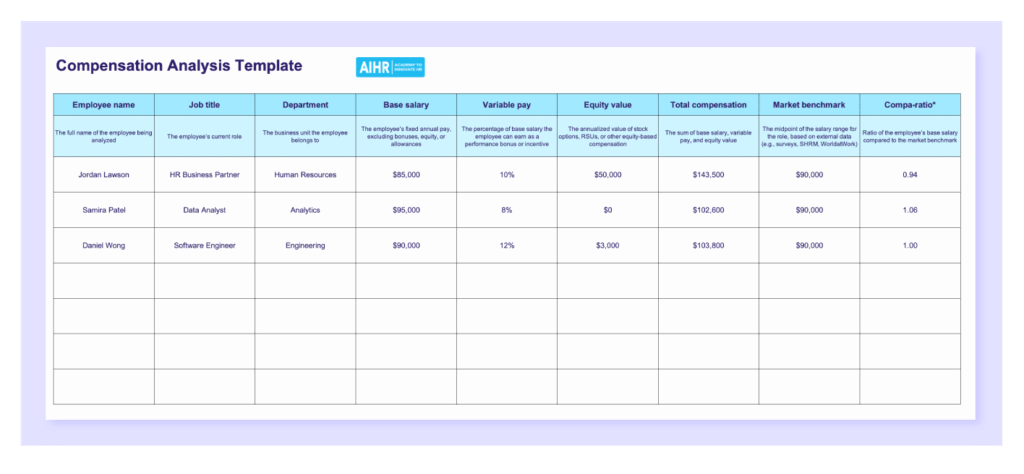
If you want to go further, AIHR also provides other free compensation-related resources that can help you strengthen your pay strategy from different angles:
Compensation package templates
A good compensation package goes beyond base salary and includes bonuses, benefits, and perks that align with your organization’s goals and employee needs. This guide walks you through 11 steps for building a comprehensive package and includes free templates you can adapt to your own workforce.
Compensation plan template
A compensation plan provides the framework for how pay decisions are made and communicated. This resource explains the seven key steps to building an effective plan and offers a customizable template to help you structure compensation policies, ensure fairness, and support long-term business goals.
Conducting a compensation analysis: 9 HR tips
The following nine HR tips will help guide you in the process of conducting a compensation analysis:
1. Gather accurate internal data first
Before comparing pay externally, make sure your internal data is clean and up-to-date. Include salaries, bonuses, benefits, tenure, and job titles. It’s also worth double-checking job descriptions to ensure they reflect actual responsibilities, since mismatched data can distort your analysis.
2. Use reliable sources for market data
Use trustworthy sources like salary surveys, government databases, or HR associations. Free online data can be tempting, but it may not reflect your industry or region accurately. Also, combining multiple reliable sources gives you a stronger foundation for a compensation market analysis.
3. Be mindful of legal considerations
Always review your findings while adhering to equal pay laws and other regulations. Pay gaps based on gender, race, or other protected characteristics can lead to significant legal and reputational risks. At the same time, maintain clear, consistent documentation of your process to demonstrate compliance if questioned.
4. Update your analysis regularly
Markets move quickly, so pay practices that were competitive a year ago may no longer apply. Conduct a compensation analysis annually – or every six months in fast-changing industries like tech – to stay on track and ahead of competitors.
5. Involve leadership early
Bring leadership and finance into the process from the very beginning. Early alignment ensures any recommendations you make will fit within budget and support company strategy, rather than being challenged after the fact.
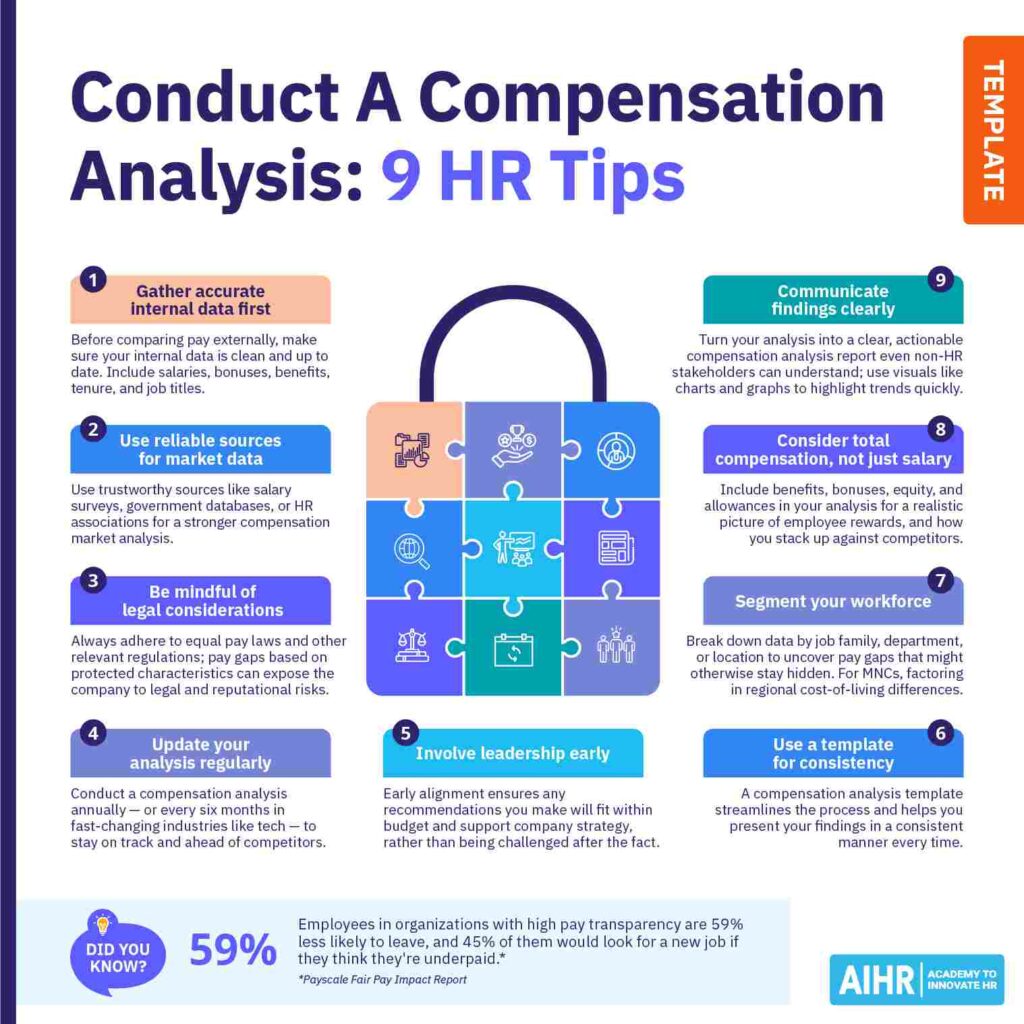
6. Use a template for consistency
A compensation analysis template streamlines the process and helps you present your findings in a consistent manner every time. This consistency makes it easier to track trends, compare results year over year, and communicate clearly with stakeholders.
7. Segment your workforce
Don’t just look at company-wide averages — break down data by job family, department, or location to uncover pay gaps that might otherwise stay hidden. For multinational organizations, factoring in regional cost-of-living differences is especially important.
8. Consider total compensation, not just salary
Include benefits, bonuses, equity, and allowances in your analysis. This provides a realistic picture of how the company rewards employees, as well as how it stacks up against competitors who may offer strong perks (even if the base pay is lower).
9. Communicate findings clearly
Turn your analysis into a clear, actionable compensation analysis report. Avoid jargon and present insights in a way even non-HR stakeholders can understand. Visuals such as charts and graphs can highlight trends quickly and help leadership make informed decisions.
6 compensation analysis examples
Here are six examples of different types of compensation analysis and how to conduct the analysis in each context:
Example 1: New hires
When extending job offers, use a compensation analysis to compare proposed salaries against both market data and internal benchmarks. These competitive pay levels for new hires do not create pay gaps. For instance, you might benchmark an offer against industry salary surveys and your existing pay structure before finalizing the compensation package.
Example 2: Pay equity reviews
To ensure fair pay for employees doing similar work, conduct regular pay equity reviews. A compensation analysis can uncover disparities related to gender, race, or tenure you may not otherwise see. You can then document the findings in a compensation analysis report and recommend adjustments to promote equity and comply with relevant laws.
Example 3: Promotion adjustments
When you promote employees into more senior roles, their pay should reflect their added responsibilities. Here, a compensation analysis helps you compare the new role against both external benchmarks and internal peers. This way, you can set a fair, competitive salary that accounts for the promotion while keeping your pay structures consistent.
Example 4: Market adjustments
Industries and salary ranges shift quickly. Running a compensation analysis allows you to track these changes and adjust your pay structures. For example, if market data shows a 10% increase in software engineers’ salaries in the past year, you can recommend raising your company’s pay ranges to ensure competitiveness and help retain key talent.
Example 5: Retention strategies
To drive employee retention, use a targeted compensation analysis to identify individuals who may be underpaid compared to peers or the market. You can then recommend retention bonuses, salary adjustments, or other incentives. A clear compensation analysis report gives leadership the evidence they need to act to prevent top talent from resigning.
Example 6: Mergers and acquisitions
Aligning pay structures is critical during mergers or acquisitions. A compensation analysis allows you to compare roles, pay ranges, and benefits across both organizations. By documenting this in a compensation analysis report, you can recommend adjustments that ensure fairness, remove inconsistencies, and support a smoother integration.
To sum up
Organizations have been reporting average merit increases of around 3.6%, and many expect little change in upcoming budgets. Meanwhile, pay transparency is rising fast: 82% of U.S. organizations have begun to share or are planning to share salary ranges with their employees.
That makes comprehensive compensation analysis more essential than ever. It gives you the facts you need to make fair, competitive, and strategic compensation decisions, and the opportunity to use compensation analytics as a tool for compliance, equity, and trust. Stick with best practices to build a pay strategy that serves both your people and business.


